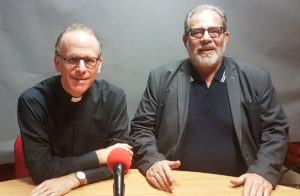Fr. Paul Oberholzer SJ and Dr. Alessandro Sattanino have started experimenting using applied multimedia didactics coupled with frontal lessons (i.e. blended e-learning) in an educational workshop launched a year and a half ago. Students’ feedback has been very positive which makes us more motivated to continue on this path.  Nevertheless, multimedia education is still in statu nascendi, with a need for evaluation, vision, and challenge identification. The goal is to fully understand how the digital world is affecting the way we learn and think as well as how we should take the most out of it.
Nevertheless, multimedia education is still in statu nascendi, with a need for evaluation, vision, and challenge identification. The goal is to fully understand how the digital world is affecting the way we learn and think as well as how we should take the most out of it.
It is widely recognized that our society has landed in a digital world. This new environment has a deep influence on young generations which doesn’t stop at the Gregorian’s doors. Being aware of it, many universities have started e-learning projects based on different approaches. We are traversing an uncertain path alternating success and failure.
Medieval History is pioneering a blended e-learning experiment at the Gregorian University, supported by Rector Nuno Gonçalves and Academic Vice Rector, Fr. Hans Zollner, SJ. For a year and a half, Fr. Paul Oberholzer SJ, who teaches History of the Medieval Church, has teamed with Dr. Alessandro Sattanino, a senior expert in charge of the development of multimedia projects, in order to experiment with forms of proper integration of multimedia material (recordings, clips, graphics, pictures) as a support for teaching.
Observing students’ behavior and inclinations and their background, it is clear that the preliminary notions they can apply to the study of Medieval Historiography are very disparate. For Europeans, the Middle Ages are part of their historical identity although linked to prejudices and myths. Overseas students, on the other hand, touch this Age for the first time, but quickly recognize its relevance for the understanding of today’s Church.
To meet these needs, we decided that the first step would be to create multimedia support giving access to basic notions (dates, events, wars, characters, etc.) We felt this was especially necessary for students of other cultures who often struggle to follow the lessons in a foreign language.
We started with the audio-recording of the lessons of an entire semester, providing an overview of the era in its ecclesiastical, social and political aspects. Recordings were made inside a radio studio to achieve the best sound quality, coming as close as possible to classroom teaching in order to take advantage of the didactic momentum. We then added a graphic layer consisting of images, keywords, animations and short written sentences in order to obtain a cognitive reinforcement that goes well beyond pure audio. Because the attention span in front of a screen is quite limited, the lessons were broken into short but comprehensive segments, defined as “Learning Objectives”. In the end 42 different video-clips were produced, with an average duration of 7 minutes each, dealing with different topics of Medieval History at an introductory level.
We consider this collection of Learning Objects as being very close to a new form of handbook. It has great potential with regards to facilitating comprehension, since students can re-play the clips as many times as they want.
We experimentally published all the video-clips on YouTube together with the transcripts of the spoken words. If they wish, students can also display subtitles in Italian or in another foreign language that are automatically generated by the platform (the quality of the automatic translation is acceptable, but for the future we hope to find resources to revise the transcription and the translations to obtain a better result.)
We carried out a survey among students and received very positive feedback, not only from foreign students but also from native Italians. They all felt this new support tool was useful for better exam preparation. It is also remarkable that the existence of the video-clips did not cause any decrease in classroom attendance!
In the next academic year, it is our intention to develop an advanced course that will enlarge and deepen the topics covered. We also look forward to experimenting with the use of video-clips for a more ambitious purpose: students will be required to prepare for classroom lessons by watching the video-clips of the introductory course, as well as through traditional readings.
This should avoid the repetition of basic notions (dates, events) in the classroom, and give time to carry out more in-depth reflections. We believe the end-result should be the appropriation of wider content.
And the next step, if we have the resources for it, will be to review all the material produced in order to also introduce teaching elements that can guide the students with preliminary questions and reflections before the discussion in the classroom. We will try to transfer to the Learning Objects a dialogical and reflective didactic approach, that can facilitate a deeper critical acquisition of knowledge during the live lessons.
Paul Oberholzer SJ oberholzer@unigre.it
Alessandro Canessa Sattanino sattanino@unigre.it


